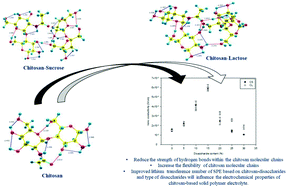The role of disaccharides as a plasticizer in improving the interaction between chitosan chain based solid polymer electrolytes (SPEs)
Abstract
The presence of hydroxyl groups that can act as active sites to interact with cations has led to the potential usage of disaccharides as plasticisers. In this research, density functional theory (DFT) was used to understand theoretically the effect of disaccharides such as sucrose and lactose on chitosan chains. Theoretical studies showed that the chitosan–disaccharide combination weakens the hydrogen bond in the chitosan molecular chain itself. The effect of disaccharides on the electrochemical properties of chitosan-based solid polymer electrolytes (SPEs) was further confirmed experimentally. Chitosan-based SPEs incorporated with lithium nitrate (LiNO3) and disaccharides were produced via a solution casting technique. Electrochemical impedance spectroscopy (EIS) analysis showed that the highest ionic conductivity for both types of disaccharides was at 15 weight percent (wt%) and the incorporation of disaccharides in chitosan increased the lithium transference number (TLi+) in the chitosan-based SPEs to ∼0.26. This study proved the potential of disaccharides as plasticisers for polymer electrolyte system-based chitosan as they can increase the flexibility of chitosan molecular chains, thus enhancing the conductivity and dissociation of ions.



 Please wait while we load your content...
Please wait while we load your content...